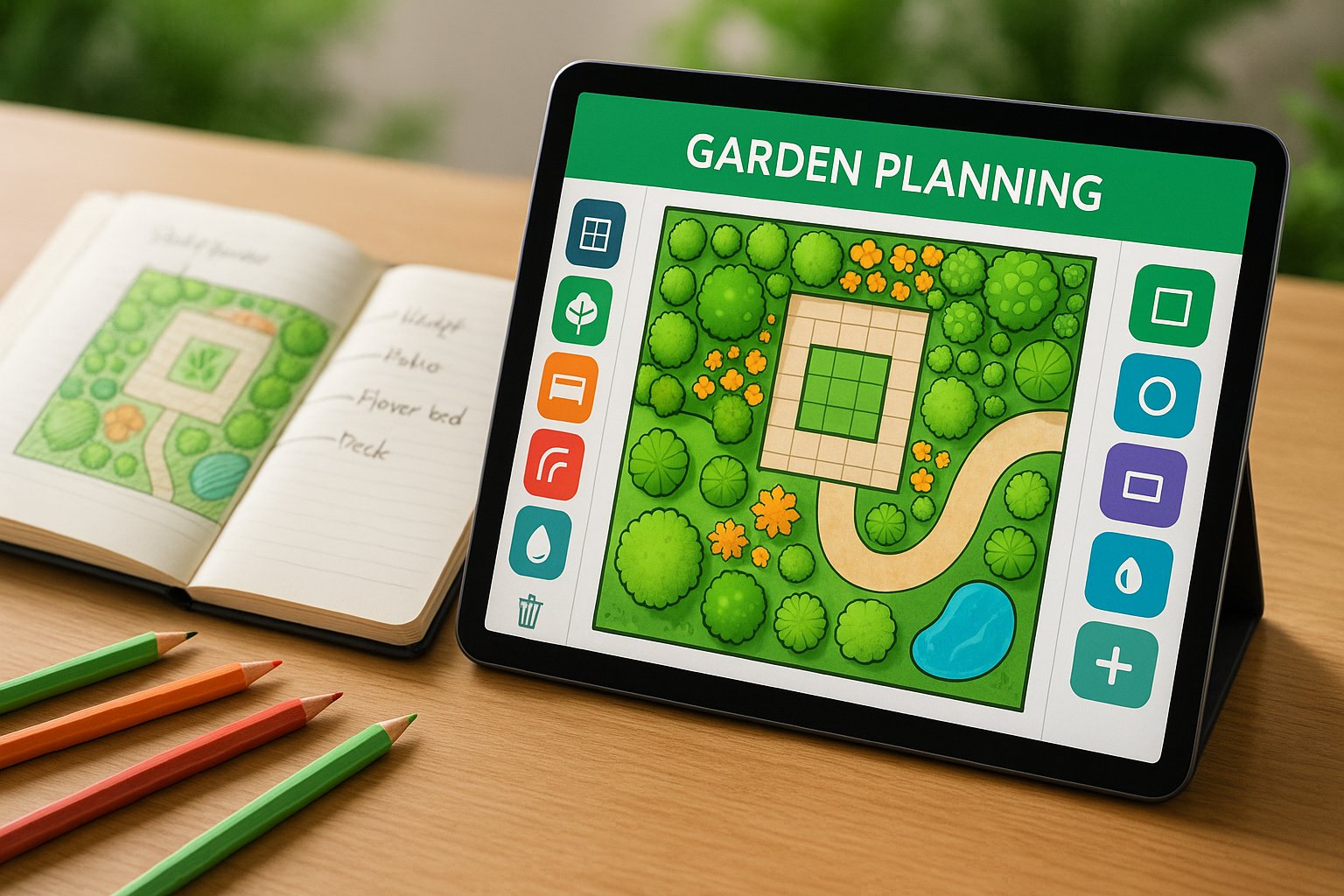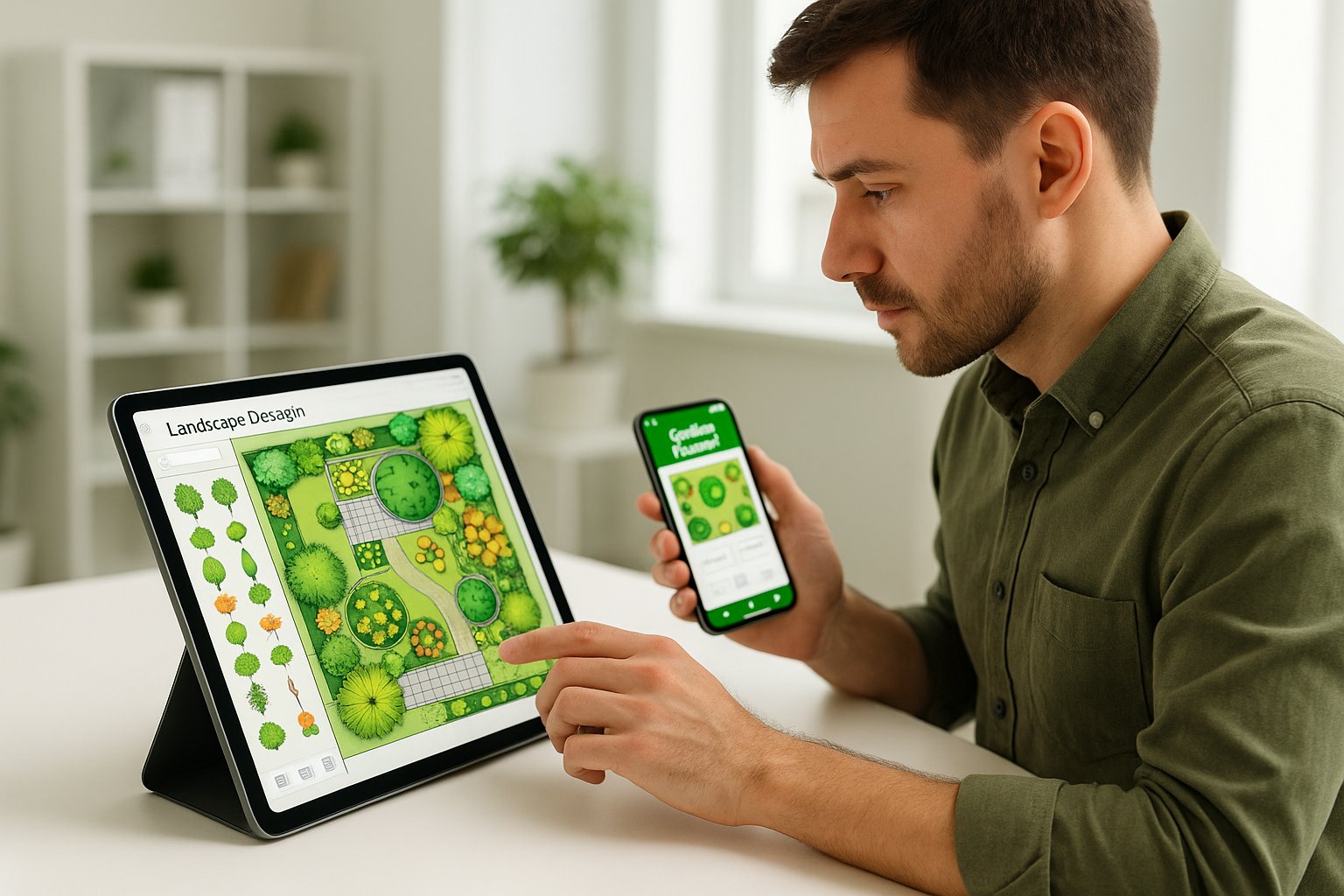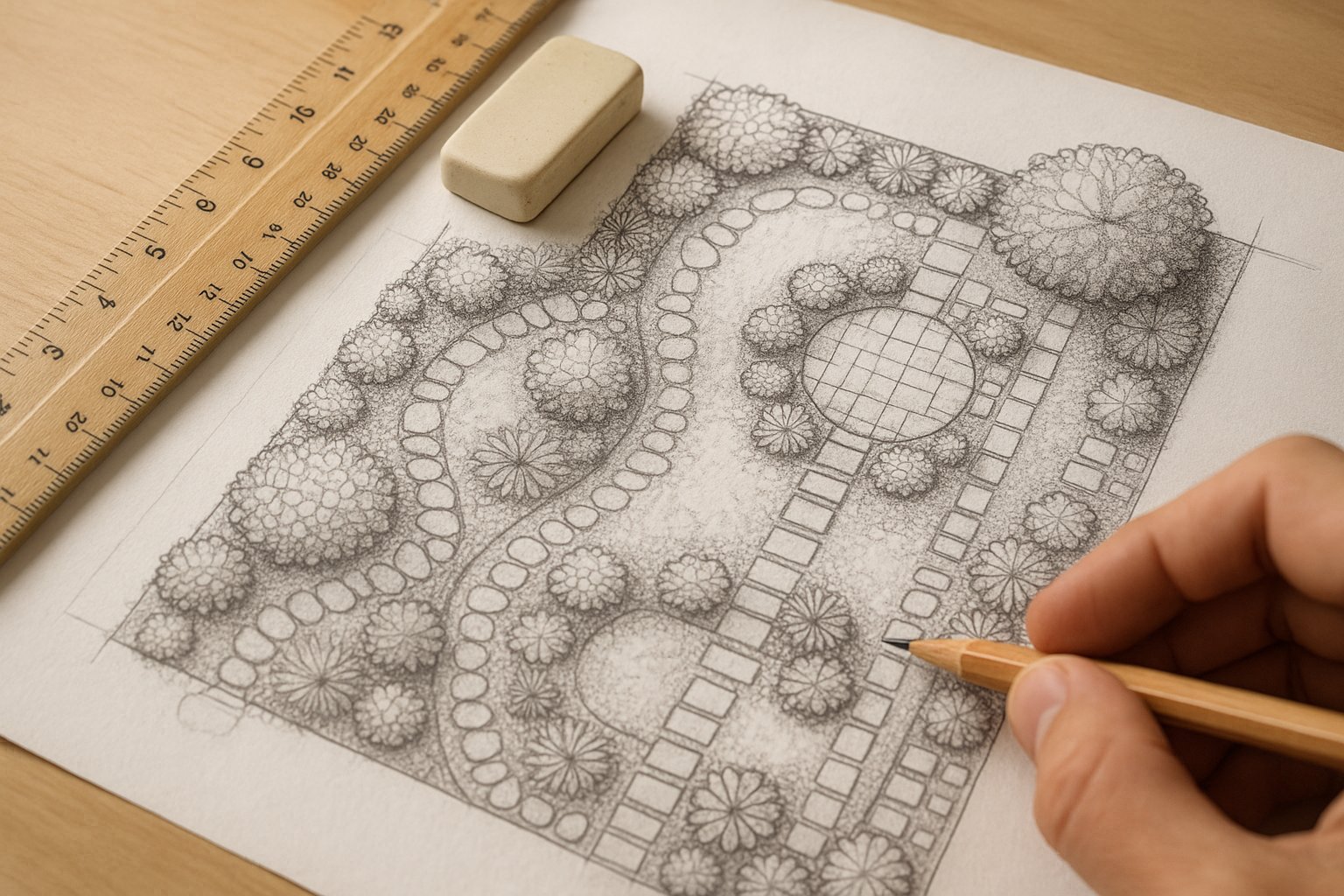Digital vs Traditional Garden Planning Methods: Finding the Right Approach for Your Project
When to use computer software, when to stick with pencil and paper, and why the best approach often combines both
Introduction
There’s something deeply satisfying about sketching garden ideas on paper, measuring spaces with a tape measure, and working through design problems with nothing more than a pencil and your imagination. But there’s also something magical about seeing your future garden in photorealistic 3D, walking through it virtually, and making changes with a few clicks.
The question isn’t really whether digital or traditional garden planning methods are better - they’re both brilliant tools for different situations. The real question is knowing when to use which approach, and how to get the best results from each.
We’ve used both methods for decades, and we’ve learned that the most successful projects often combine traditional creativity with digital precision. Sometimes a quick hand sketch during a site visit is exactly what’s needed. Other times, detailed CAD drawings and 3D visualizations prevent expensive mistakes.
Let’s explore when each approach works best, what you can expect from each method, and how to choose the right planning approach for your specific project.

Traditional Garden Planning: The Time-Tested Approach
What Traditional Planning Involves: Hand-drawn plans, physical measuring tools, paper overlays, and the kind of face-to-face consultation that’s been creating beautiful gardens for centuries.
The Classic Toolkit:
- Quality vellum paper for detailed drawings
- Lead pencils ranging from hard (3H) to soft for different line weights
- Architect’s scales for accurate proportional drawing
- Circle templates for plant symbols
- Colored pencils or markers for presentation drawings
The Process: Traditional planning starts with site visits and careful measurement. Designers create base maps on paper, develop concepts through hand sketching, and present final designs as beautifully rendered drawings.
Why It Still Works: There’s an immediacy to traditional planning that digital methods can’t match. You can sketch ideas while walking the site, respond instantly to client questions, and develop concepts without being tied to a computer screen.
Digital Garden Planning: The Modern Revolution
The Digital Advantage: Computer-aided design brings mathematical precision, 3D visualization, and the ability to make major changes without starting over.

Software Categories:
- Professional CAD programs like Vectorworks and AutoCAD
- Mid-range options like SketchUp and PRO Landscape
- User-friendly apps like Planner 5D and SmartDraw
- Emerging AI-powered design tools
What Digital Tools Offer: Precise measurements, automatic scaling, 3D walkthroughs, realistic plant growth simulation, and the ability to share designs instantly with clients or contractors.
The Transformation: Digital planning has democratized garden design. Sophisticated tools that once required years of training are now accessible to anyone with a smartphone.
When Traditional Methods Excel
Initial Concept Development: Nothing beats a pencil and paper for exploring ideas. Hand sketching encourages creative thinking and allows for rapid concept exploration without the constraints of software interfaces.
Site Consultation: During site visits, traditional sketching allows immediate response to client ideas and site conditions. You can capture the energy of the moment and develop concepts collaboratively.
Personal Connection: Many clients appreciate the personal touch of hand-drawn plans. There’s something special about receiving a beautifully rendered drawing that feels crafted specifically for their garden.
Small, Simple Projects: For basic planting schemes or simple layout changes, traditional methods are often faster and more cost-effective than learning software or hiring digital design services.
Budget Considerations: Traditional planning requires minimal upfront investment. Quality drawing tools cost €200-500 once, while professional software can cost thousands annually.

Local Expertise: Traditional designers often bring deep local knowledge that software can’t replicate - understanding of Irish soil conditions, climate patterns, and regional plant preferences.
When Digital Methods Shine
Complex Projects: Large gardens with multiple elements, precise grading requirements, or integration with existing structures benefit enormously from digital precision.
Accuracy Requirements: When measurements matter - drainage calculations, structural elements, or planning permission submissions - digital tools provide the precision needed.
Client Visualization: 3D renderings and virtual walkthroughs help clients understand spatial relationships and make confident decisions about major investments.
Revision Efficiency: Digital plans can be modified quickly and easily. Want to see how the garden looks with different paving? Change it in minutes rather than redrawing everything.
Professional Presentation: For commercial projects or high-end residential work, polished digital presentations often carry more weight with decision-makers.
Long-Distance Projects: Digital tools enable effective collaboration when face-to-face meetings aren’t practical.
The Cost Reality Check
Traditional Planning Costs:
- Initial tool investment: €200-500
- Professional consultation: €50-150 per hour
- Design development: 8-15 hours typical residential project
- Revisions: 2-4 hours per major change
Digital Planning Investment:
- Software costs: €0 (free apps) to €5,000+ annually (professional CAD)
- Learning time: Weeks to months depending on complexity
- Hardware requirements: €1,000-3,000 for capable computer
- Professional services: Often 20-30% premium over traditional
Long-Term Value: Digital tools become more cost-effective as project complexity and volume increase. Traditional methods remain economical for simple, one-off projects.
Learning Curves and Time Investment
Traditional Skills Development: Learning to draw well takes practice, but basic sketching skills can be developed in weeks. Professional-quality presentation drawings require months of practice.
Digital Proficiency Timeline:
- Simple apps: 1-2 weeks to basic competency
- Mid-range software: 1-3 months for effective use
- Professional CAD: 6-12 months for true proficiency
The Reality: Both approaches require significant time investment for professional results. The difference is that traditional skills transfer between projects immediately, while digital skills become more valuable over time.
Accuracy and Precision Comparison
Traditional Accuracy: Hand-drawn plans typically achieve ±2-5cm accuracy, which is sufficient for most garden planning. However, human error in scaling and measurement can create problems.
Digital Precision: CAD software provides millimeter-accurate measurements and eliminates scaling errors. This precision is essential for complex construction projects.
When Precision Matters: Drainage systems, retaining walls, planning applications, and coordination with other trades all benefit from digital precision.
When Approximation Works: Planting layouts, general arrangement plans, and concept development often work perfectly well with traditional approximation.
Client Communication Effectiveness
Traditional Presentation Strengths:
- Personal connection during site visits
- Immediate response to questions and concerns
- Tangible drawings that clients can keep and study
- Collaborative development during meetings
Digital Communication Advantages:
- 3D visualization eliminates guesswork
- Before-and-after comparisons show transformation clearly
- Remote sharing enables convenient collaboration
- Multiple design options easily presented
Generational Preferences: Younger clients often prefer digital presentations, while older clients frequently appreciate traditional drawings. The best approach matches the client’s preferences.
The Hybrid Approach: Best of Both Worlds
Our Recommended Process:
- Initial consultation: Traditional site visit and hand sketching for immediate idea capture
- Concept development: Hand-drawn exploration of different layout options
- Design refinement: Transfer promising concepts to digital for precision and development
- Client presentation: Combine hand sketches with digital renderings for comprehensive communication
- Construction documentation: Digital plans for accurate contractor guidance
Why Hybrid Works: This approach captures the creative spontaneity of traditional methods while providing the accuracy and visualization of digital tools.
Project Adaptation: Simple projects might stop after step 2, while complex projects might spend most time in steps 4-5. The process adapts to project needs and budget.
Irish Professional Context
Professional Standards: Irish professional bodies like the Garden and Landscape Designers Association (GLDA) and Irish Landscape Institute (ILI) support both traditional and digital approaches while emphasizing local expertise.
Planning Requirements: Irish planning applications increasingly expect professional-quality drawings. Digital tools often provide the precision and presentation quality required.
Local Considerations: Successful Irish garden design requires understanding of local soil conditions, climate patterns, and native plants - knowledge that comes from experience rather than software.
Professional Investment: Most established Irish landscape professionals use hybrid approaches, investing in digital tools while maintaining traditional skills for client consultation.
DIY vs Professional Considerations
DIY-Friendly Traditional: Basic sketching and planning are accessible to anyone. Graph paper, measuring tape, and colored pencils can produce effective results for simple projects.
DIY Digital Options: Free apps like Planner 5D and SketchUp Free provide sophisticated capabilities without professional software costs.
When to Hire Professionals:
- Complex drainage or grading issues
- Planning permission requirements
- Projects exceeding €5,000 value
- Integration with existing structures
Professional Value: Experienced designers bring local knowledge, technical expertise, and the ability to visualize solutions that software alone cannot provide.
Common Mistakes with Each Method
Traditional Planning Pitfalls:
- Poor scale consistency across drawings
- Inadequate site analysis missing important details
- Overcrowded designs not accounting for mature plant sizes
- Difficulty communicating complex spatial relationships
Digital Planning Problems:
- Over-reliance on software templates lacking site-specific character
- Precision without practicality - technically perfect but unimplementable designs
- Inadequate learning investment leading to inefficient workflows
- Technology dependence creating vulnerability to system failures
Universal Planning Mistakes:
- Starting design before comprehensive site analysis
- Ignoring architectural style integration
- Poor plant selection for local conditions
- Inadequate budget planning
Choosing the Right Approach
Project Size Guidelines:
- Small gardens (under €2,000): Traditional or simple digital apps
- Medium projects (€2,000-€10,000): Hybrid approach
- Large projects (€10,000+): Professional digital with traditional consultation
Complexity Factors:
- Simple planting schemes: Traditional adequate
- Multiple elevations or drainage: Digital essential
- Structural elements: Digital precision valuable
- Planning permission: Professional digital often required
Client Preferences:
- Technology-comfortable clients: Digital presentation effective
- Traditional preferences: Hand-drawn plans appreciated
- Remote clients: Digital collaboration necessary
- Local clients: Traditional site consultation valuable
Future Trends and Emerging Technologies
AI Integration: Artificial intelligence is beginning to generate multiple design options automatically, potentially revolutionizing the early concept phase while maintaining the need for human expertise in refinement.
Virtual and Augmented Reality: VR walkthroughs and AR overlays are becoming more accessible, providing immersive client experiences without expensive professional equipment.
Smart Garden Integration: Modern gardens increasingly incorporate smart irrigation, lighting, and monitoring systems that require digital planning for proper integration.
Sustainability Focus: Both traditional and digital approaches are adapting to emphasize sustainable design, native plants, and climate resilience.
Making Your Choice
Start with Your Project: The right approach depends more on project requirements than personal preference. Match the method to the complexity and budget.
Consider Your Timeline: Traditional methods provide immediate results, while digital approaches require learning investment but offer long-term efficiency gains.
Think About Communication: How do you prefer to work with clients or family members? Some people connect better with hand sketches, others with 3D visualizations.
Budget Realistically: Include learning time and software costs in digital planning budgets. Factor in revision capabilities when comparing total project costs.
Plan for Growth: If you’re planning multiple garden projects, digital tool investment may pay off over time.
Integration with Professional Services
Working with Traditional Designers: Hand-drawn plans require clear communication about revisions and expectations. Ensure you understand the revision process and costs.
Digital Design Collaboration: Digital tools enable more efficient collaboration, faster revisions, and clearer construction communication.
Hybrid Professional Services: Many professionals now offer traditional consultation with digital deliverables, combining personal service with modern precision.
Conclusion: The Right Tool for the Right Job
The choice between digital and traditional garden planning isn’t about which is “better” - it’s about matching the tool to the task. Traditional methods excel at creativity, personal connection, and site-responsive design. Digital tools provide precision, visualization, and efficient revision capabilities.
The most successful approach often combines both: traditional creativity for concept development and client connection, digital precision for technical development and construction documentation.
Ready to Start Planning Your Garden? Whether you choose traditional sketching, digital design, or a hybrid approach, success starts with understanding your site conditions. Our site analysis guide provides the foundation information needed for any planning method.
Want to understand how planning methods fit into overall garden development? Our 7-step garden design process shows how both traditional and digital approaches integrate with successful garden creation.
After all, the best planning method is the one that helps you create the garden you’ll love - whether that involves pencils and paper, computer screens and software, or a thoughtful combination of both.
For guidance on choosing planning approaches for your specific project, consult with local landscape professionals who can assess your needs and recommend the most effective combination of traditional and digital methods.